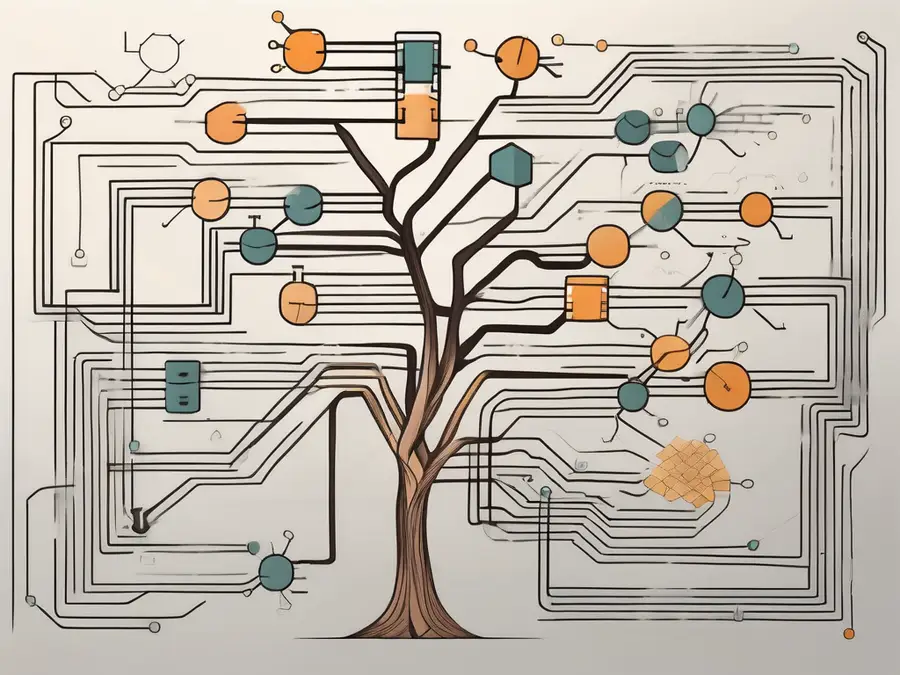A Comprehensive Guide to Merkle Trees

Merkle Trees are a fundamental concept in computer science and cryptography, playing a crucial role in ensuring data integrity, enhancing scalability, and improving security in various applications. In this comprehensive guide, I will take you through the basics of Merkle Trees, their importance in blockchain technology, the process of building them, their relevance in cryptography, and even touch upon advanced concepts like Merkle Proofs. So, fasten your seatbelts and let's dive deep into the world of Merkle Trees!
Understanding the Basics of Merkle Trees
If you're new to the concept of Merkle Trees, don't worry! I'll explain it in simple terms. Merkle Trees, also known as hash trees or binary hash trees, are data structures that allow efficient and secure verification of the integrity of large datasets. They are hierarchical structures composed of hash values, which are unique identifiers generated through cryptographic hash functions.
But let's dive a little deeper into the world of Merkle Trees and explore their definition and function.
Definition and Function of Merkle Trees
A Merkle Tree is a tree-like structure in which every non-leaf node is a hash of its child nodes, and every leaf node contains a hashed data block or transaction. This hierarchical arrangement allows for efficient verification of data integrity.
Imagine you have a dataset consisting of a large number of data blocks or transactions. Instead of verifying the integrity of the entire dataset, which can be time-consuming and resource-intensive, Merkle Trees provide a way to verify specific parts of the dataset without having to download the entire thing.
How does this work? Well, by traversing the tree and comparing hash values, you can efficiently verify the integrity and authenticity of specific data blocks or transactions. This is because any modification to a single data block or transaction will result in a different hash value, causing a mismatch when compared to the original hash value stored in the Merkle Tree.
Now that we understand the basic concept of Merkle Trees, let's take a closer look at the key components that make up these structures.
Key Components of a Merkle Tree
A Merkle Tree consists of three essential components:
- Leaf Nodes: These are the bottom-most nodes of the tree, representing individual data blocks or transactions. Each leaf node contains a hash value associated with the respective data block or transaction. These hash values act as unique identifiers for each block or transaction.
- Branch Nodes: These nodes serve as intermediaries between the leaf nodes and the root node. A branch node is a hash value that results from hashing the concatenation of its two child nodes. In other words, it represents the combined hash values of its children.
- Root Node: This is the top-most node of the Merkle Tree and represents the entire dataset. The root node is computed by hashing the concatenation of its child nodes and serves as a unique identifier for the dataset. Any change in the data blocks or transactions will result in a different root node hash value.
By having these key components in place, Merkle Trees enable efficient verification of data integrity and authenticity, making them a crucial component in various fields, including blockchain technology.
Now that we have a solid understanding of the basics of Merkle Trees, let's explore their significance in blockchain technology and how they contribute to the security and efficiency of distributed ledgers.
The Importance of Merkle Trees in Blockchain
Blockchain technology has revolutionized the way we think about trust and transparency in various industries. Merkle Trees play a pivotal role in the integrity and security of blockchain. Let's take a closer look at two key aspects: ensuring data integrity and enhancing scalability and efficiency.
Ensuring Data Integrity with Merkle Trees
Data integrity is crucial in any system, but it becomes even more critical in blockchain, where the decentralization and immutability of data are essential. Merkle Trees enable the verification of individual transactions within a block, allowing participants to validate the integrity of the entire blockchain without downloading the entire chain.
Each block in a blockchain contains a Merkle Tree where the root node represents the entire block. By comparing the root node's hash value with the hash value stored in the blockchain, anyone can quickly determine if the block has been tampered with or modified. This provides a transparent and efficient way to maintain the integrity of the blockchain.
Furthermore, Merkle Trees allow for efficient auditing of the blockchain. With the ability to verify individual transactions, auditors can easily track the flow of assets and ensure compliance with regulations. This level of transparency and accountability is particularly valuable in industries such as finance and supply chain management.
Enhancing Scalability and Efficiency
Scalability is a significant challenge in blockchain systems, as they need to handle a growing number of transactions. Merkle Trees offer an elegant solution to this problem. By dividing the database into chunks and creating Merkle Trees for each chunk, the overhead of verifying the entire dataset is significantly reduced.
Instead of verifying the entire blockchain, participants can verify individual chunks and then corroborate their authenticity through the Merkle Tree's root nodes. This approach greatly improves scalability, as it allows for parallel verification of multiple chunks, resulting in faster and more efficient blockchain systems.
In addition to scalability, Merkle Trees also enhance the efficiency of blockchain systems. With the ability to verify individual transactions and chunks, unnecessary data can be pruned, reducing the storage requirements and improving overall system performance. This optimization allows blockchain networks to handle larger transaction volumes and accommodate a greater number of participants.
Moreover, Merkle Trees enable the implementation of light clients, which are essential for mobile and resource-constrained devices. These light clients can verify the integrity of transactions and blocks by relying on the Merkle Tree's root nodes, without the need to download and store the entire blockchain. This capability opens up new possibilities for blockchain adoption in various industries and use cases.
In conclusion, Merkle Trees are a fundamental component of blockchain technology, providing the means to ensure data integrity and enhance scalability and efficiency. With their ability to verify individual transactions and chunks, Merkle Trees offer a transparent and efficient way to maintain the integrity of the blockchain, while also addressing the scalability challenges faced by blockchain systems. As blockchain continues to evolve and find applications in diverse industries, the importance of Merkle Trees cannot be overstated.
The Process of Building a Merkle Tree
Now that we understand the importance of Merkle Trees in blockchain, let's delve into the process of building one. Building a Merkle Tree involves two main steps: step-by-step construction and understanding hash functions.
Step-by-Step Construction of a Merkle Tree
The construction of a Merkle Tree follows a recursive process from the bottom-up. Let's walk through the steps:
- Start with the individual data blocks or transactions, representing the leaf nodes of the Merkle Tree.
- Compute the hash value for each leaf node using a cryptographic hash function such as SHA-256.
- If the number of leaf nodes is odd, duplicate the last leaf node to create an even number of nodes.
- Group the leaf nodes into pairs and concatenate the hash values of each pair.
- Generate hash values for each pair by hashing the concatenated values.
- Repeat steps 4 and 5 until a single hash value, the Merkle Root, is obtained.
And voila! You've successfully constructed a Merkle Tree.
Understanding Hash Functions in Merkle Trees
Hash functions are an integral part of Merkle Trees. They play a crucial role in assigning unique identifiers to each data block or transaction and in verifying the integrity of the tree structure.
A hash function takes an input and produces a fixed-size output, known as the hash value or hash digest. It is designed to be deterministic, meaning that the same input will always result in the same hash value. Additionally, a hash function should be collision-resistant, making it computationally infeasible to find two inputs that produce the same output.
Popular hash functions used in Merkle Trees include SHA-256, SHA-3, and Blake2. These hash functions provide the necessary cryptographic security and efficiency required for Merkle Tree operations.
Merkle Trees in Cryptography
While Merkle Trees find extensive application in blockchain, their utility extends to other areas of cryptography as well. Let's take a closer look at their roles in secure communications and digital signatures.
Role of Merkle Trees in Secure Communications
Merkle Trees are employed in various cryptographic protocols to ensure the authenticity and integrity of transmitted data. In the context of secure communications, Merkle Trees can enable efficient detection of tampered data during transmission.
Imagine transmitting a large file over an unreliable network. By dividing the file into smaller chunks and creating a Merkle Tree, you can efficiently verify the integrity of each chunk at the receiver's end. If any chunk is found to be tampered with, only that specific chunk needs to be retransmitted, rather than the entire file.
Merkle Trees in Digital Signatures
Digital signatures play a vital role in verifying the authenticity and integrity of digital documents. Merkle Trees can enhance the efficiency of digital signatures by reducing the verification time and computational overhead.
In the context of digital signatures, Merkle Trees are used to store the public keys of participants. By organizing the public keys in a Merkle Tree structure, the verification process becomes more efficient. Instead of verifying each participant's key individually, it is possible to verify multiple keys simultaneously by traversing the branches of the Merkle Tree.
Advanced Concepts in Merkle Trees
Now that we have covered the basics of Merkle Trees and their applications in blockchain and cryptography, let's explore some advanced concepts that further enhance their utility. In this section, we will delve into Merkle Proofs and explore Merkle Roots and Merkle Paths.
Exploring Merkle Proofs
Merkle Proofs provide an elegant way to prove the inclusion or absence of data in a Merkle Tree without revealing the entire tree structure. It is a compact cryptographic proof that allows anyone to verify the membership or non-membership of data in a Merkle Tree.
With Merkle Proofs, it becomes possible to efficiently prove that a specific data block or transaction is included in a Merkle Tree. This capability finds applications in verifying the integrity of data stored in decentralized systems like blockchain, where trust is distributed among multiple participants.
Understanding Merkle Roots and Merkle Paths
The Merkle Root is the top-most node of a Merkle Tree and serves as the unique identifier for the entire dataset. It is computed by hashing the concatenation of its child nodes. The Merkle Root plays a pivotal role in verifying the integrity of the entire dataset using a compact hash value.
Merkle Paths, on the other hand, provide a concise way to prove the membership of a specific data block or transaction in a Merkle Tree. A Merkle Path consists of the hash values of the nodes traversed from the leaf node to the root node, forming a chain of cryptographic proof. By combining the Merkle Path with the Merkle Root, anyone can efficiently verify the inclusion of a data block or transaction in the Merkle Tree.
Throughout my years of expertise in blockchain and cryptography, I have witnessed the transformative power of Merkle Trees in ensuring data integrity, enhancing scalability, and improving security. They prove to be a powerful methodology to maintain the integrity of decentralized systems, allowing participants to verify information efficiently and securely.
Remember, Merkle Trees are not just theoretical concepts but practical tools that have contributed to the advancement of technology. By leveraging the power of Merkle Trees, we can build systems that are more efficient, scalable, and secure.
FAQ
What are Merkle Trees?
Merkle Trees are hierarchical data structures that enable efficient and secure verification of the integrity of large datasets. They consist of hash values that represent individual data blocks or transactions and culminate in a root node, known as the Merkle Root, which represents the entire dataset.
What is the role of Merkle Trees in blockchain?
Merkle Trees play a crucial role in maintaining the integrity and security of blockchain systems. They enable efficient verification of individual transactions within a block, enhance scalability through parallel verification of data chunks, and provide transparency through the verification of the Merkle Root.
How do you build a Merkle Tree?
To build a Merkle Tree, start with the individual data blocks or transactions. Compute the hash value for each leaf node, group them into pairs, and hash the concatenated values to generate hash values for each pair. Repeat this process until a single hash value, the Merkle Root, is obtained.
What are Merkle Proofs?
Merkle Proofs are cryptographic proofs that provide a concise way to prove the inclusion or absence of data in a Merkle Tree without revealing the entire tree structure. They allow efficient verification of the membership or non-membership of data, contributing to enhanced integrity and security in decentralized systems.
How do Merkle Trees enhance scalability in blockchain?
Merkle Trees enhance scalability in blockchain by dividing the database into chunks and creating Merkle Trees for each chunk. This allows for parallel verification of multiple chunks, reducing the overhead of verifying the entire dataset and resulting in faster and more efficient blockchain systems.
In conclusion, Merkle Trees are a powerful concept in computer science and cryptography that provide efficient and secure methods for verifying data integrity, enhancing scalability, and improving security. Whether you're exploring blockchain, secure communications, or digital signatures, a solid understanding of Merkle Trees will undoubtedly benefit your journey into the world of decentralized and secure systems.
As you've learned, Merkle Trees are integral to the security and efficiency of blockchain technology, which is at the heart of innovative trading platforms like Morpher. Embracing the principles of decentralized systems, Morpher.com offers a trading experience that's not only secure but also incredibly flexible. With the ability to trade a wide array of assets, enjoy zero fees, and benefit from features like fractional investing and 10X leverage, Morpher is truly democratizing the world of investing. Ready to experience the future of trading? Sign Up and Get Your Free Sign Up Bonus at Morpher today and join the revolution.

Disclaimer: All investments involve risk, and the past performance of a security, industry, sector, market, financial product, trading strategy, or individual’s trading does not guarantee future results or returns. Investors are fully responsible for any investment decisions they make. Such decisions should be based solely on an evaluation of their financial circumstances, investment objectives, risk tolerance, and liquidity needs. This post does not constitute investment advice.

Painless trading for everyone
Hundreds of markets all in one place - Apple, Bitcoin, Gold, Watches, NFTs, Sneakers and so much more.

Painless trading for everyone
Hundreds of markets all in one place - Apple, Bitcoin, Gold, Watches, NFTs, Sneakers and so much more.









